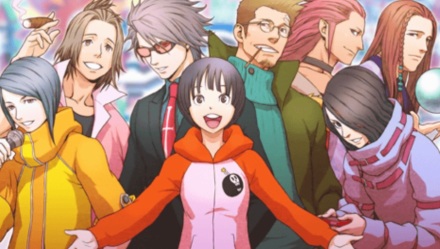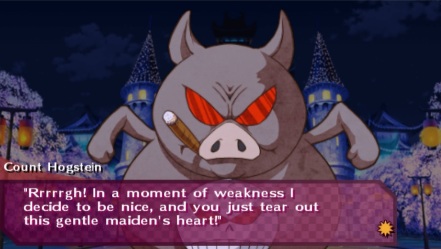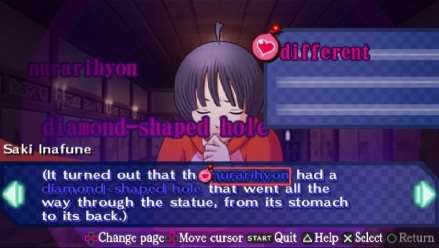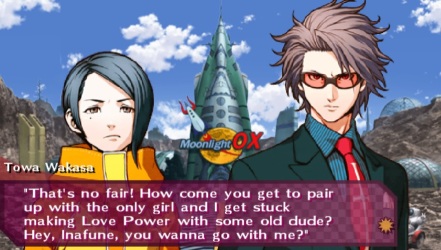(It occurred to me as I was writing this piece that I was essentially trying to cram two very different essays into one, and this was making it read terribly. On the other hand, though, I also couldn’t bring myself to cut either argument, so I wound up splitting it into two sections to be published separately for the sake of length, clarity, and spoilers. This part deals with the game’s six main routes, and has only vague spoilers for content.)
I have spent months wondering if gaming has a female equivalent to the power fantasy of violence which is so standard in the business, and what such a thing might look like. I don’t think that kind of thing is one-size-fits-all, because games about power through violence, even those with optionally female protagonists, don’t scratch that fundamental itch for me; I want to be respected for more than just my prowess at dishing out death and diplomacy. Similarly, I’ve tried a whole lot of otome games – dating sims pitched at a female audience – without really feeling like they wanted to imbue me with any real sense of strength or agency, at least beyond my choice of love interest early on.
I think the kind of power fantasy I’m talking about would involve a compulsory female protagonist who is liked and respected by the men and women around her, not because of her skill at shooting things, but because she is capable as a person and damn well comes to earn it. And as the player, I should be made to feel competent too, because her victories are intimately mine. I can finally say this with confidence, because this game exists and I have played it. It’s a PSP title called Sweet Fuse: At Your Side, and it’s a shame that barely anyone has heard of it.
The premise of Sweet Fuse should be pretty familiar: the opening of a theme park is hijacked by the cartoonish Count Hogstein, who blows up the Ferris wheel and takes many of the civilians there hostage. Seven participants are chosen from the crowd, including your protagonist Saki Inafune, and made to play a week-long survival game which involves working together to beat various challenges in the park. Not only are their own lives at stake, but the survival of the hostages also hinges upon their success. As the game progresses, though, it becomes apparent that there’s a larger mystery at play than just the identity of the culprit: why were these people selected to participate in this death game, and what thread connects their fates?
This all sounds pretty intense, but the game is fundamentally light-hearted in a way that most other entries in the genre aren’t: the body count remains close to zero throughout, barring a couple of bad ends, and it’s also the funniest game I’ve played by a mile. The ensemble cast have strong personalities without being grating, and they’re so different from the usual archetypes that it isn’t hard to think of them as people. It also has a very strong sense of fun and wears its heart on its sleeve: this is, after all, a game where you play as Keiji Inafune’s fictional niece, so it hardly starts off very serious. Characters banter almost constantly, with Wakasa being a particularly sarcastic standout, and the dialogue is by turns self-referential, humorous, and touching. The party overcomes Hogstein’s challenges not only through lateral thinking, but also by enacting ridiculously elaborate plans that play to their eclectic mix of strengths. (One in particular – and I swear this actually happens – is won solely because a certain participant makes a blog post.) Yet this never undermines the plot when it takes tense or dramatic turns, and there are some genuinely shocking revelations in many of the later routes which coexist easily with their early silliness.

Left to right: Towa Wakasa, Makoto Mikami, Subaru Shidou, Saki Inafune,
Ayumu Shirabe, Ryusei Mitarashi, Kouta Meoshi, Kimimaro Urabe.
There are six routes initially available, one for each of the other participants in the game, with a seventh “secret character” becoming available after clearing an initial playthrough. They’re all romances, although that aspect feels secondary to surviving and uncovering more of the mystery, and it kicks in quite late in the route besides. In order to best enjoy the overarching plot and preserve the twists, it’s suggested you play every possible path in a particular sequence. First is teen popstar Towa Wakasa, then antisocial gamer Kouta Meoshi, affable escort Ryusei Mitarashi, cryptic clairvoyant Kimimaro Urabe, hardworking cop Subaru Shidou, and cynical journalist Ayumu Shirabe. There’s also the unlockable Makoto Mikami, who doesn’t appear in any other path, and whose route I’ll be dealing with in depth in Part Two.
Throughout all the routes, there’s a strong feeling that these men genuinely grow to count on each other, and also on you. Better yet, it doesn’t even take that long to earn their respect, and by the end of the first challenge you’re already taking steps towards being a cohesive team. Even when one of their number is outed as a traitor and captured by Hogstein, the group doesn’t break faith with him, and in most routes he winds up getting rescued and rejoining the party for later challenges. It’s really easy to see why any of these men might fall for Saki – or vice versa – when they so clearly trust each other and value their strengths, and this lends believability to what would otherwise be a whirlwind romance.
On top of that, there is precisely one occasion in all of Sweet Fuse when your protagonist become the subject of a sexist comment. About an hour in, Saki rashly reaches out for part of a particular puzzle, and Shidou yells at her because a woman “shouldn’t touch that thing”. Rather than excusing his behaviour, though, the game gives you the option to either restrain yourself, or to get angry and call him out for his sexist comment. Not only does choosing anger get him to apologise and promise it won’t happen again, but you even gain an affection point for setting him straight.
This mechanic, dubbed What’s Wrong With You? after the phrase Saki shouts, allows you to get angry with people who are being particularly awful and keeps cropping up throughout the entire game. It’s an absolute breath of fresh air, but also a sharp break from the convention in romance arcs that you do nothing but agree with the person you’re pursuing. (In its most memorable occurrence, getting angry with the dying body of your love interest quite literally results in them coming back to life. Choosing to hold back, on the other hand, nets you a game over.) Not only can you scream at your teammates when they’re being irrational and awful, but you can even do the same to Count Hogstein when he decides to be especially unfair. The game’s willingness to grant you agency over your reactions as well as your dialogue is incredibly empowering; unlike most other otome protagonists, you can refuse to simply be knocked around by forces beyond your control.
This is particularly prominent in Mitarashi’s route; all the guys feel some obligation to protect Saki, but Mitarashi has a particular tendency to get between her and any possible danger with little thought for himself. During the first opportunity you have to gain affection with him, he takes a crossbow bolt to the shoulder for you. As with Shidou, the option which gains you affection is to question his actions, although in this case it doesn’t involve the What’s Wrong With You? mechanic. This pattern continues for much of his path: although he keeps taking hits for you, the game at least allows you to call him a moron when he does, and he’ll like you better if you do.
Additionally, the plot almost never sidelines you, and your male companions need to be rescued or sit out at least as often (barring part of two problematic but compelling routes). And on the occasions someone else takes a bullet for you, nine times out of ten you’ll be able to berate your saviour for being reckless. Saki is never someone that needs to be protected or a prize to be won, but a crucial part of the team. She may not have Shidou’s leadership or Wakasa’s charm or Meoshi’s reflexes or Urabe’s insight or Mitarashi’s brawn or Shirabe’s general knowledge, but she is optimistic and clever and never gives up and as valued a team member as any of them. Most other otome games would only give your protagonist positivity, tops, and even then it usually feels like a tokenistic strength in lieu of actually being able to do anything.
Not only do the characters in Sweet Fuse respect you for your capability, but the game itself rewards you for thinking critically. This is partially evident in the puzzle-game element of certain challenges, in a segment called Explosive Insight, which requires you to review everything you’ve learned in order to seek a way forward much like Ace Attorney or Dangan Ronpa. It involves choosing three phrases from a pool of about seven or eight, with one of them being a crucial point you’ve previously overlooked that will help you solve a puzzle. Their implementation is somewhat flawed – you only get one shot at Explosive Insight, and it’s easy to screw up because the terms you’re choosing from often overlap – but, as with any puzzle game, there’s a definite feeling of satisfaction when the answer clicks in your head.
However, it goes deeper than that, and competence being set up as its own reward is also true of the way the story as a whole is structured. The game genuinely trusts you, the (presumably) female player, to be clever enough to slowly put together the pieces of a larger plot at work, and to theorise as you go. The framework of the plot is put together in such a way that paying attention is genuinely satisfying, and I found myself with no less than four constantly-updating sticky notes crammed with information about what I’d learned. The final route – Mikami’s – has a twist which is pretty obvious if you’ve been keeping up, and so the game doesn’t waste time trying to make it shocking; it’s dispensed with early on the fifth day, and immediately used as fodder to draw the game as a whole together and build to a satisfying climax.
Sweet Fuse isn’t perfect, though. As I mentioned before, its puzzle aspects leave a lot to be desired, and grow particularly repetitive when you’re replaying the common route. There are a couple of problematic paths where Saki’s agency is significantly curtailed, namely those in which she gets involved with the less sane members of the cast, and she remains a somewhat vague presence throughout. Plus I wish there were more women in it, because the only other female character has a bit part and is barely relevant in most routes.
But, for all that, Sweet Fuse made me feel clever and competent and meaningful as a player, not just the character I was inhabiting. Even when I’d just failed an Explosive Insight section or gotten a bad end, I immediately wanted to reload and persevere and see what happened next. (It helps that the game has a very forgiving amount of save slots, but that’s definitely a good thing.) I know it sounds trite to suggest that a female power fantasy is one which allows you to solve problems without violence, and has the characters around you respecting that without either ignoring or compensating for gender, but I do think that Sweet Fuse’s appeal runs deeper than that. Unlike, say, Commander Shepard or any of BioWare’s other stable of heroes, Saki is just an ordinary person who has a strange and intense week. The fact that she’s nobody special, triumphing over adversity through brains and tenacity alone, helps to empower and unify both her and the player.
To paraphrase one of my favourite essays, the real hallmark of a good female character, in a story that respects her existence, is that you can quite honestly say you want to be her. And really, I think I wouldn’t mind being Saki, survival game and all. Not when she comes out the other side of it unscathed, and with half a dozen strong new friendships with men who genuinely respect her and what she’s about. Although Sweet Fuse comes dolled up in otome packaging, it’s actually one of the most genuine appeals in favour of human connection I’ve ever come across – but that’s something for next time.
(Part two here, although be warned – it contains heavy spoilers for the whole game.)





Pingback: Thoughts on Sweet Fuse, Part Two: Sincerity as Strength | Girl from the Machine
I have to agree whole heartedly with you. I’ve seen so many people bashing this because it’s not like other otome games. I loved this game!!! I specifically bought a PS3 and a Vita so I could buy this however dumb that sounds. And good thing they’re both region free so I can play all those otoges I want lol. Anyways, I wish this game did much better than it did and I have high hopes for Code Realize since so many people were saying that Cardia, the heroine, was strong and developed very well. I hope to see more of your blogs and I’m new to wordpress, so I wanted to follow you!
LikeLike